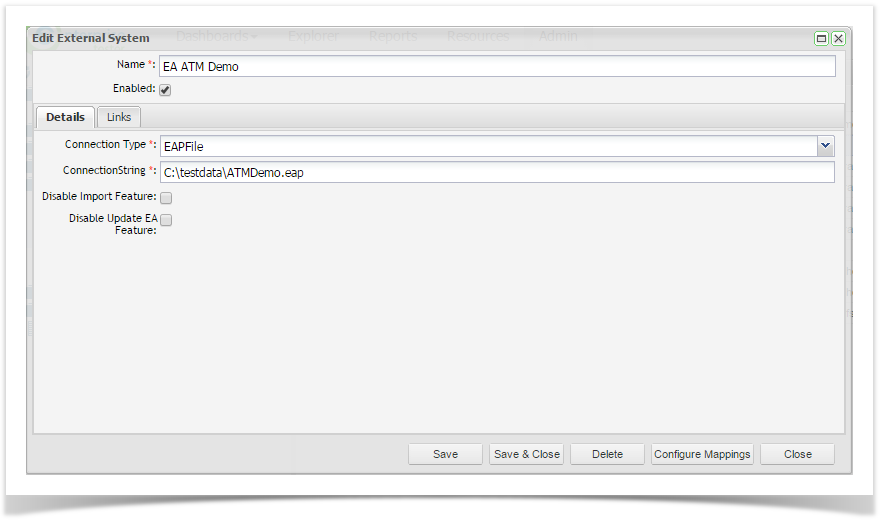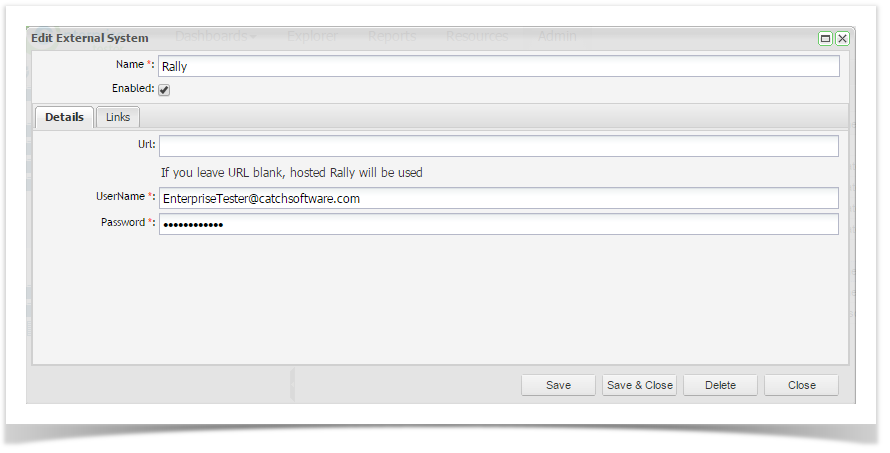Connecting to External Systems
The ability to interface with multiple external systems (defect trackers, ALMs, EA etc.) is another key feature of the tool. This interface allows incidents and/or requirements (depending on the tool you are integrating with) to be synchronized between Enterprise Tester and the external system. When synchronizing with JIRA, TFS and Rally, for all supported entities, full bi-directional synchronization is supported regardless of the system the entity (requirement / user story / incident / defect) was originally created in. The direction and scope of the synchronization is configurable when working with these external systems. When synchronizing with EA, only entities originally created in EA and imported into ET will be included in the synchronization. Only requirement updates are supported when synchronizing from ET to EA. For more information, please see the help article related to your external system in the list of help topics for configuring project links below.
Enterprise Tester interfaces with the following:
...
Enterprise Tester adds a reference to the external ticket ID on the incident. This is visible as a hyperlink on the entity or in the External Identifiers column of the entity summary screen grid.
Entity
Summary Grid
Add an External System
To add a connection to an external system:
...
- The configuration screen of the external system type you chose will appear:
Enterprise Architect
Connection Type | Select the EA repository type from the drop down list. |
Connection String | The connection string details are dependent on the connection type. See the Enterprise Architect help topic for more information. |
| Disable Import Feature | This feature disables the ability to import from EA. It can be useful if you would like to enable the feature for an import and then disable them after the process is complete to limit other users from initiating the process. When disabled, the Import button is no longer available on the project link screen. |
| Disable Update EA Feature | This feature disables the ability to update EA with the changes made in ET (updates and deletions). As the update feature will update all values in EA regardless of which system holds the latest change, this feature can give you some control over when updates are made. When disabled the Update EA button is no longer available on the requirements type project link screen. (ET does not support updating EA Use Cases so the use case type project link screen will be unaffected). |
...
The Gateway Account should be set up as an administration account in JIRA/TFS. This will allow creation, and update of incidents across all projects and will hold sufficient privileges to support enhanced functionality when further integration features are implemented.
Rally
Name | Enter a name for the external system that will identify it within Enterprise Tester. |
Enabled | Check this box to enable the connection to the external system. |
| URL | Enter the URL path for the external system. This can be left blank is you are working with a non-trial hosted instance of Rally. If you are using a trial hosted version of Rally. The URL is: |
UserName | Enter a gateway username for the external system. This user should have admin permissions and access to all relevant workspaces. |
Password | Enter the password for the gateway username. |
...
The next step is to set up your links between your ET and external projects.
Advanced Settings (JIRA and TFS Connections)
Advance settings only applies to JIRA and TFS connection. Advance settings allows you to configure which custom fields from your external system will be synchronized with ET. By default, all the custom fields in the defect tracker will be selected for synchronization.
...
Once you have updated the custom field synchronization configuration click Save and Close. A refresh lookups will also need to be performed after adding custom fields to the synchronization configuration.
Creating Project Links
For each project in ET that you wish to synchronize with a project in your external system you will need to create a project link. There are 2 areas where you can create and configure your project links: The links tab of your external system or from the Project Links on the Resources tab of the navigator.
External System Links Tab
Once you have created your connection to the external system, click on the Links tab from the Edit External System screen. Click on Add from the tool bar.
...
Once you have completed the screen click on OK. The External Links Details screen will appear. Now you will need to complete the field configuration. Please see the help topics for the tool you are integrating with. See the end of the page for a list of topic links.
Resources Tab
From the Resources tab, click to expand Project Links. To view all configured links for your project, double click on your project.
...
Once the refresh look up completes, the next step is to complete the field configurations. Please see the help topics for the tool you are integrating with in the section below.
| Anchor | ||||
|---|---|---|---|---|
|
Listed below are some additional help topics which describe the field configurations required for each external system.
...



